8 MIN READ
Benefits of Scouting Fields Before Planting Corn in the Central Corn Belt
November 14, 2022
Having knowledge of weed and insect activity in future corn fields is an important step to help maximize corn yield potential. This is especially important in no-till and continuous corn.
Weed Scouting
Scouting future corn fields in the fall and early spring can help determine which weeds are present, their population, their growth stage, and best management practices for control.1 Good weed control during the first four to six weeks after planting is critical for maintaining yield potential. A clean start helps conserve moisture and nutrients for the crop, establish good seed-to-soil contact, ensure seedlings are not shaded or competing for resources, and prevent weeds from binding up planters. Winter annual weeds that emerge in late summer through fall can overwinter and set seed in the spring and early summer. Small weed patches may not seem economical to control; however, these patches may have time to produce seed and add to the soil weed-seed bank before a burndown application or tillage is accomplished.2 Recognizing annual weeds such as waterhemp (Amaranthus tuberculaatus) and Palmer amaranth (Amaranthus palmeri) in the fall is important as they emerge later in the spring and require diligent management with residual herbicides.
Perennial weeds in no-till systems can be difficult to control because their root structures remain intact instead of being broken up as in tilled systems. Additionally, in no-till systems, weeds that produce prolific amounts of seed that germinate at or near the soil surface such as marestail (Conyza canadensis), waterhemp, foxtails (Setaria species), and others can become widespread, and many of these species have developed resistance to glyphosate and other herbicide modes of action.3 It is important to control these weeds when they are less than four-inches tall, which can require control as soon as equipment can enter the field.2 Starting clean and staying clean is important for weeds like marestail, waterhemp and Palmer amaranth, especially in soybean fields.
Common Winter Annual and Perennial Weeds (Figures 1 through 18)
Common weeds to scout for in the fall include annual bluegrass (Poa annua), common chickweed (Stellaria media), dandelion (Taraxacum officinale), downy brome (Bromus tectorum), cressleaf groundsel (butterweed) (Senecio glabellus), field pennycress (Thlaspi arvense), henbit (Lamium amplexicaule), marestail (horseweed), mouseear chickweed (Cerastium vulgatum), purple deadnettle (Lamium purpureum), Shepherd’s purse (Capsella bursa-pastoris), wild carrot (Daucus carota), wild mustard (Brassica kaber), and yellow rocket (Barbarea vulgaris). Weeds that usually emerge early spring are common lambsquarters (Chenopodium album), Canada thistle (Cirsium arvense), and common (Ambrosia artemisiifolia) and giant ragweed (Ambrosia trifida).4,5,6
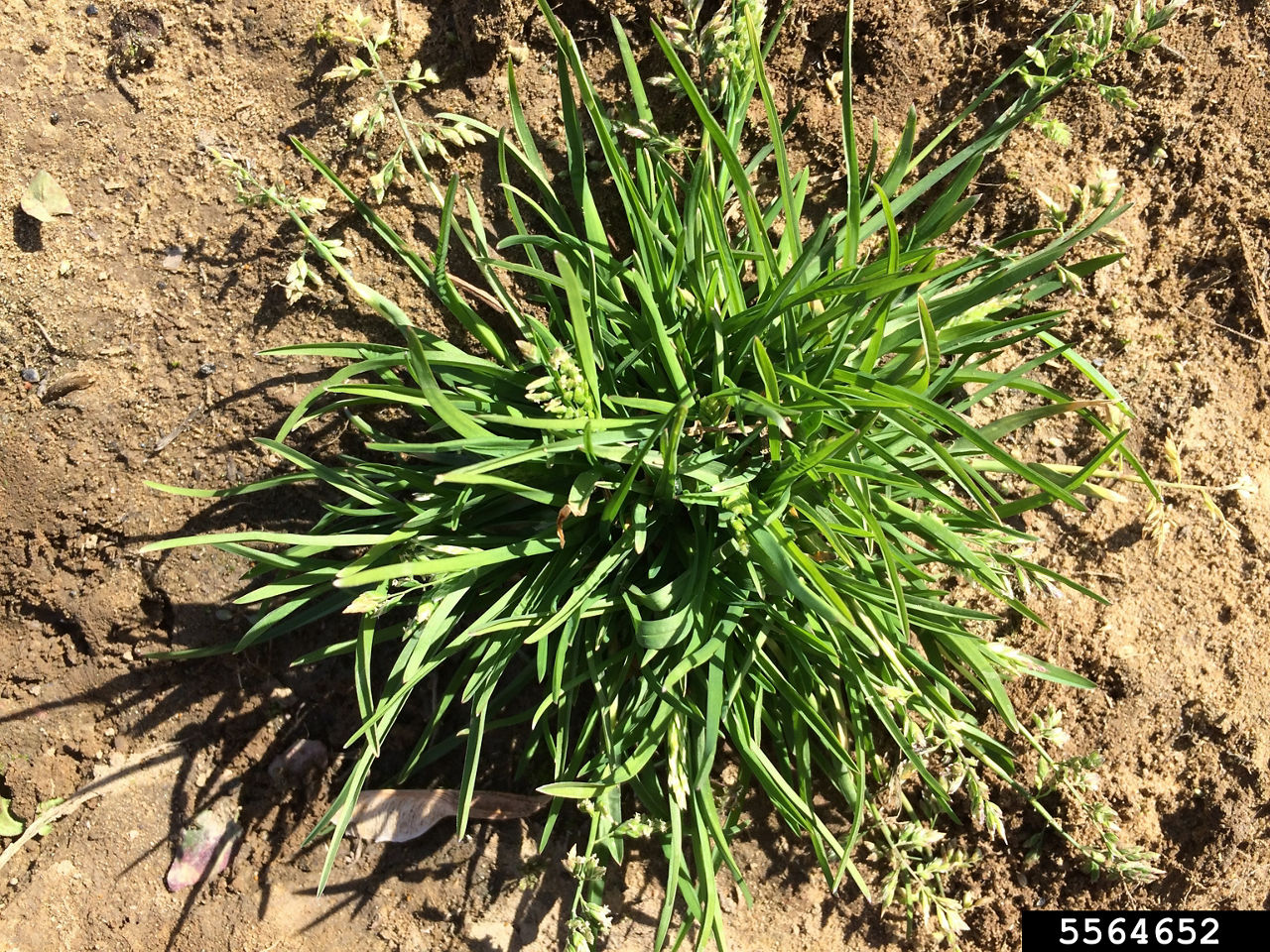
Figure 1. Annual bluegrass. Shallow-rooted grass that often roots at lower nodes and flowers by crop planting.5 Picture courtesy of and used with the permission of Shawn Wright, University of Kentucky, Bugwood.org.
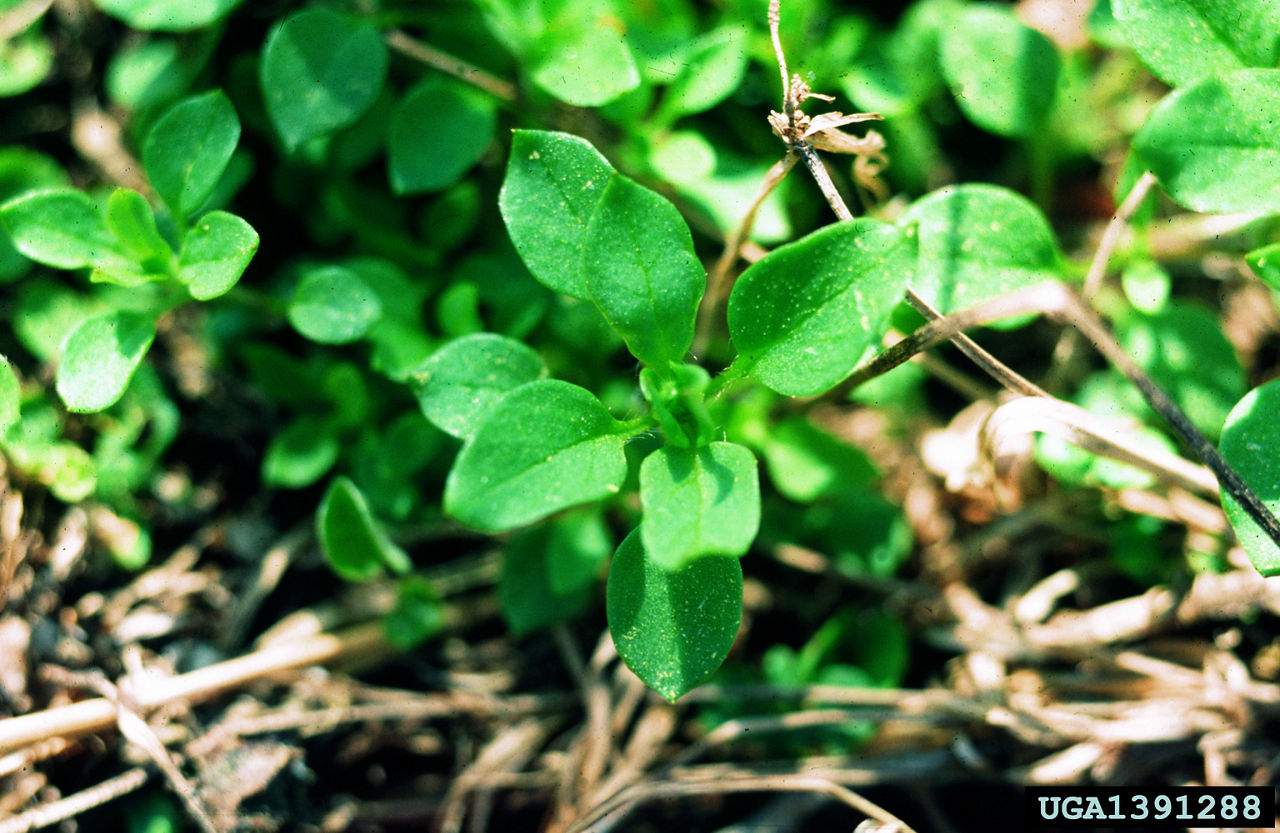
Figure 2. Common chickweed leaves are bright green, nearly rounded with pointed tips, and nearly hairless. The stem has a single straight row of hair. Picture courtesy of and used with the permission of John D. Byrd, Mississippi State University, Bugwood.org
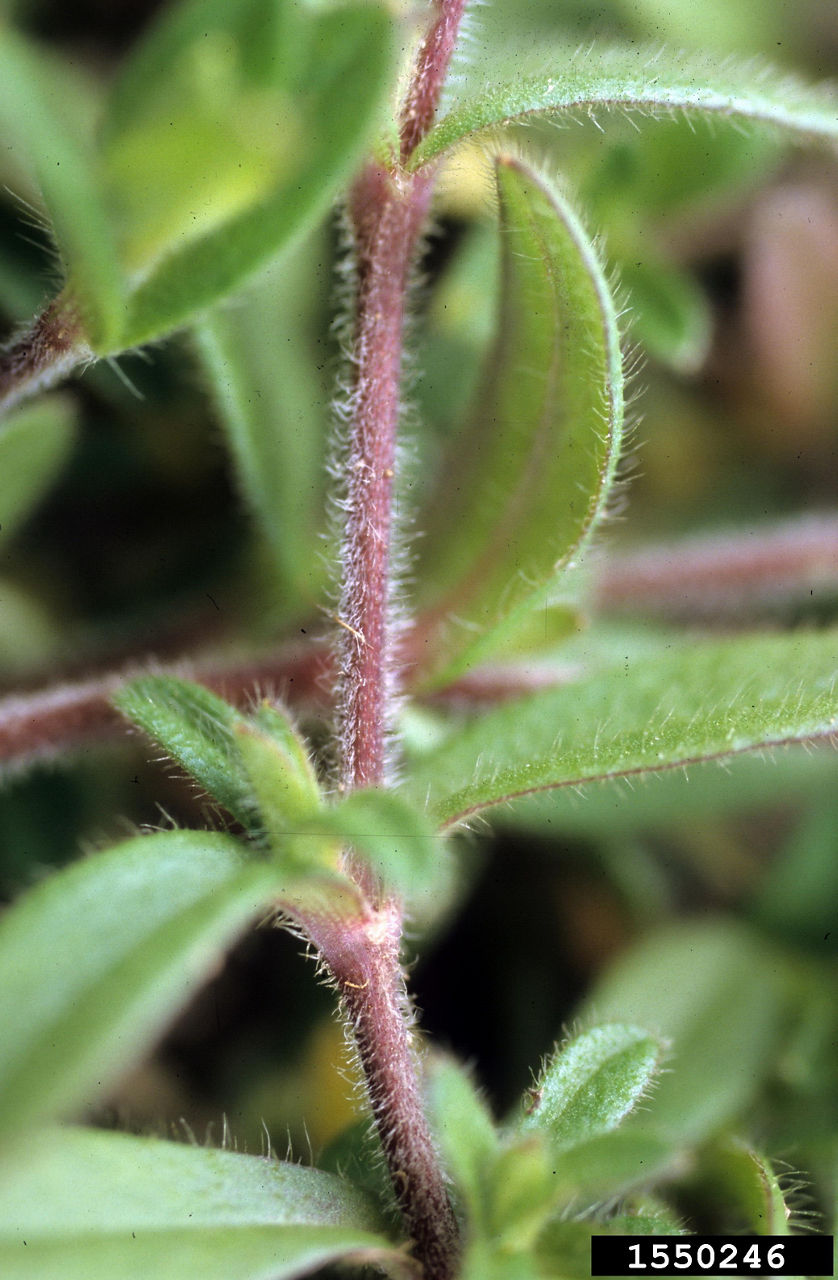
Figure 3. Mouseear chickweed leaves are dark green, elongated, and covered with soft hairs. Photo courtesy of and used with the permission of Theodore Webster, Ohio State Weed Lab, The Ohio State University, Bugwood.org.
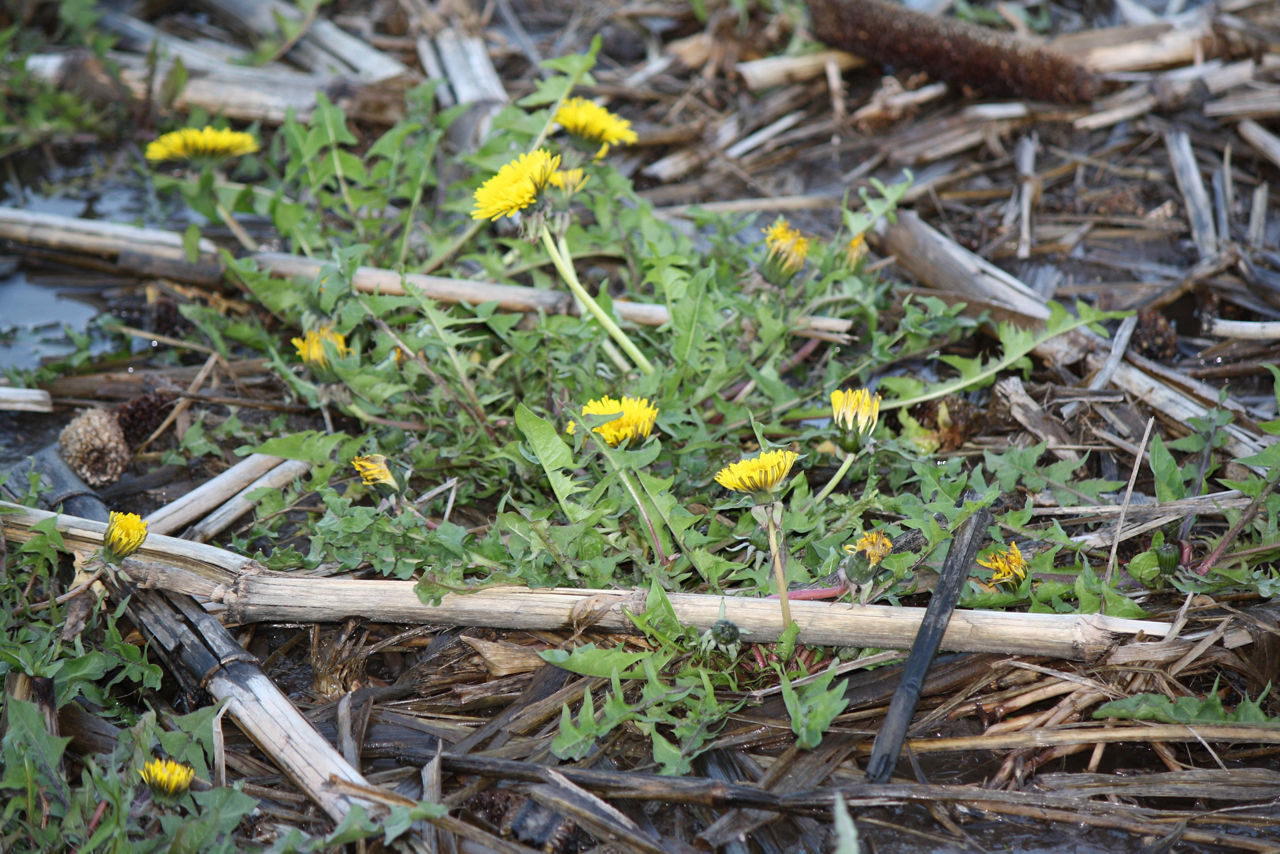
Figure 4. Dandelion leaves form points toward the center of the rosette and all plant parts exude a milky sap when broken.
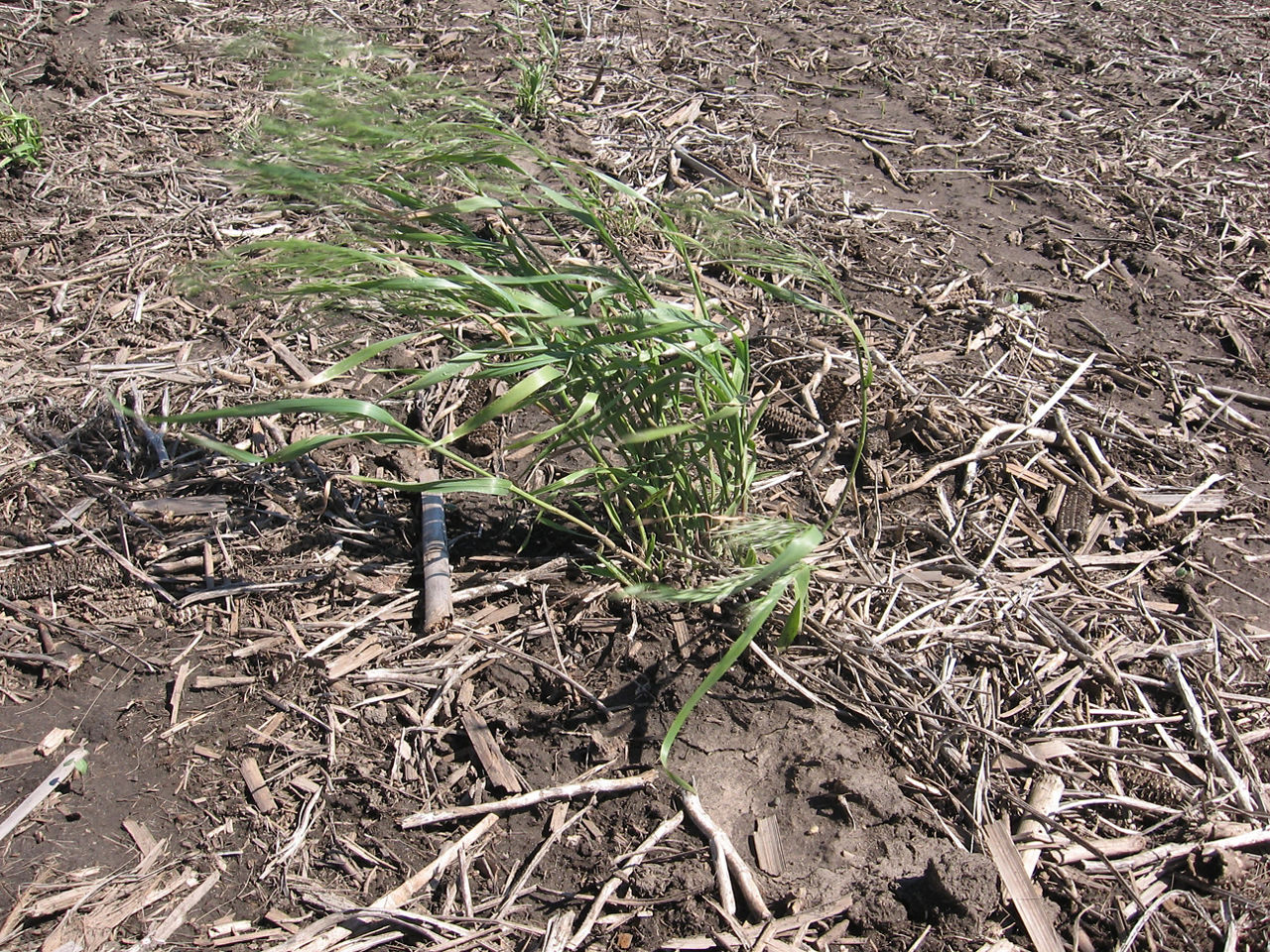
Figure 5. Downy Brome. Seedlings are light green with soft hairs on the leaf sheath and blades. Distinguished by twisted leaves and long, awned spikelets.
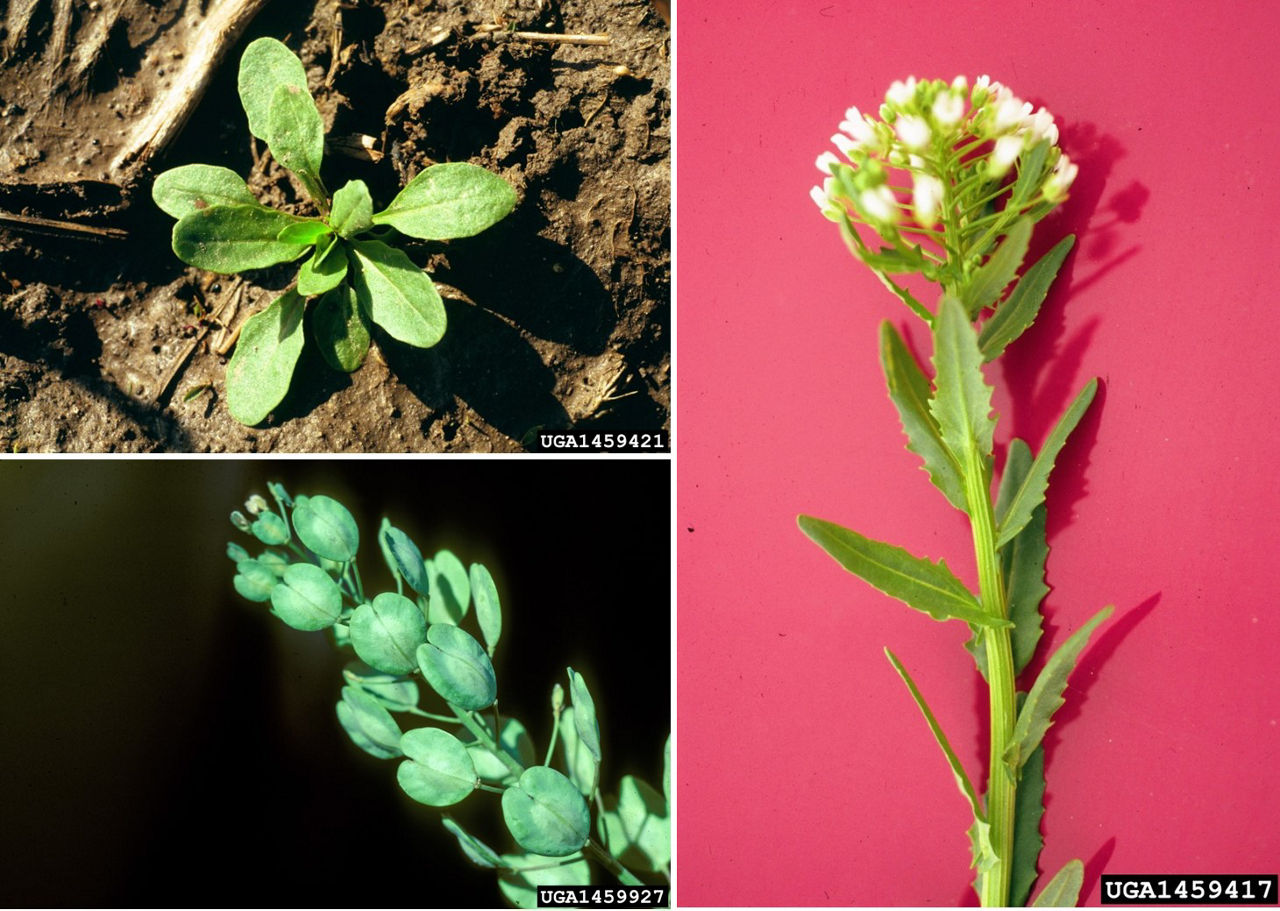
Figure 6. Field pennycress emerges as a rosette (top left), has hairless leaves attached directly to the stem with no petiole (right), and penny-shaped seeds (bottom left). Pictures courtesy of and used with the permission of Steve Dewey, Utah State University, Bugwood.org.
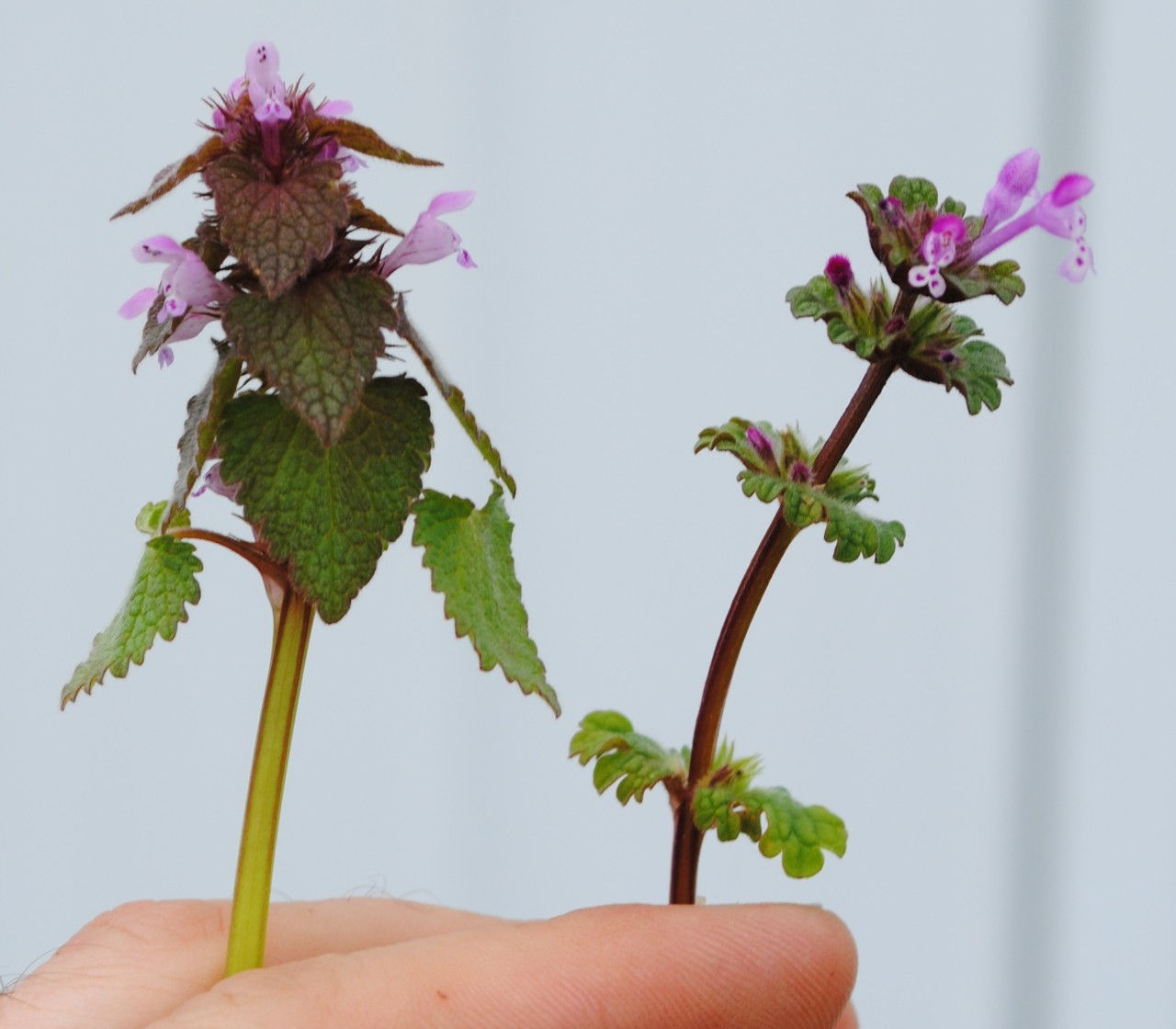
Figure 7. Purple deadnettle (left) and henbit (right) look similar and can be misidentified. They can be distinguished from each other by looking at the leaves in the upper portions of the stem. The upper leaves of purple deadnettle have short petioles that attach to the stem while henbit leaves attach directly to the stem.
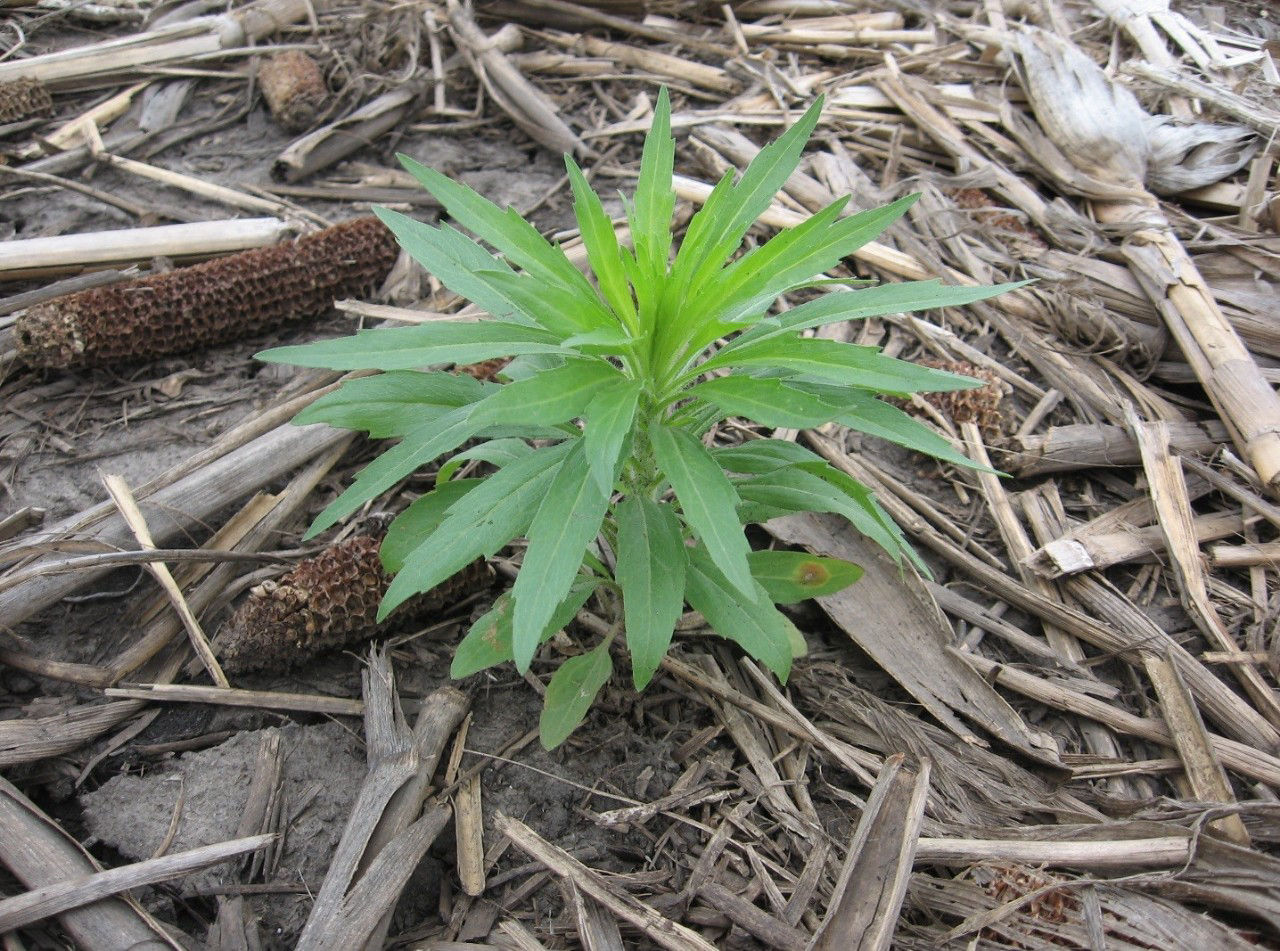
Figure 8. Marestail or horseweed forms a basal rosette after germination and seedlings are covered with coarse hair and have toothed leaf margins. Mature plants develop an erect, columnar shape and flowers are white to pink with yellow centers. Marestail is more susceptible to an herbicide application when in the rosette stage. It is important to control marestail before it is more than 4-inches tall.
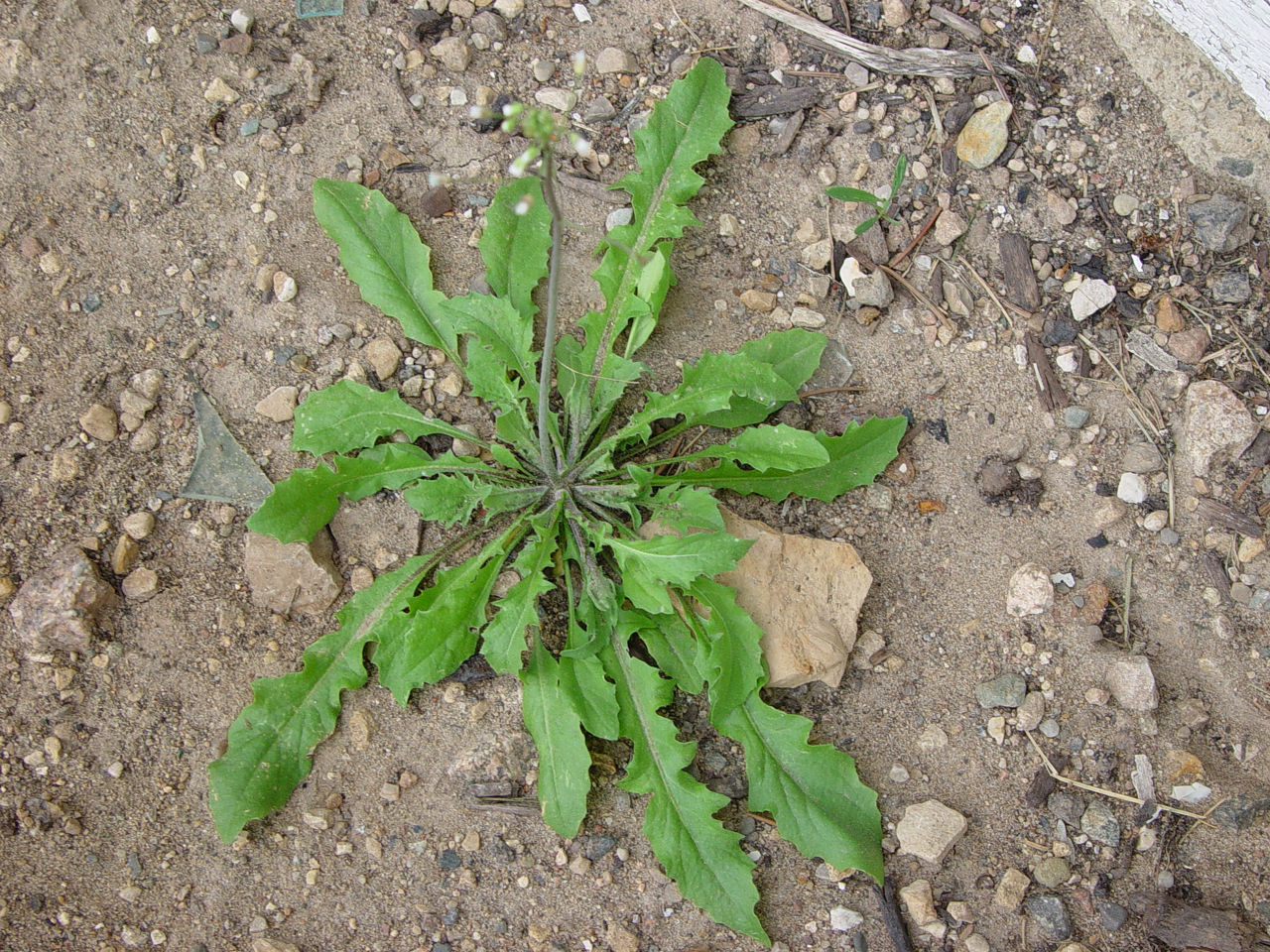
Figure 9. Shepherd’s-purse rosette. Leaves are alternate, deeply toothed, and smooth or hairy.9
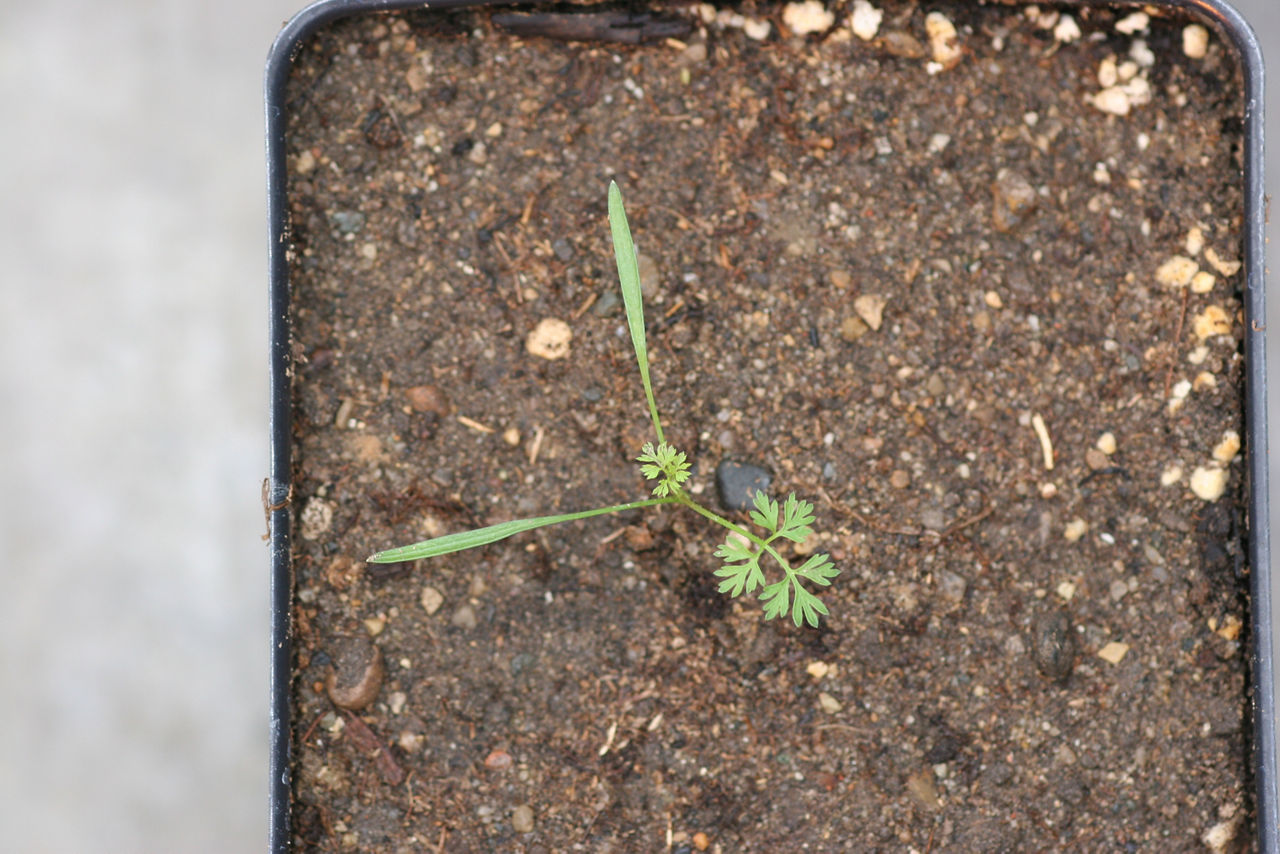
Figure 10. Wild carrot seedling. A biennial that is a rosette the first year before elongating the second year. Second-year stems are green with bristly hair and leaves are hairy.9
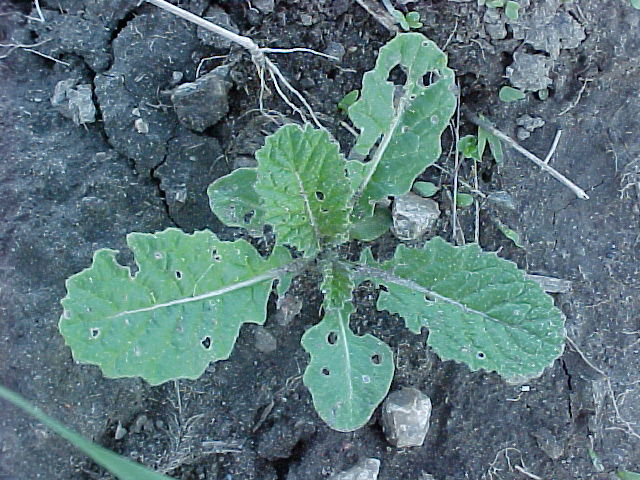
Figure 11. Wild mustard. Seedlings have cotyledons that are smooth, kidney-shaped, and prominently veined. Leaves in rosette have bristly hair. Stems have bristly hair at the base, but nearly hairless at top. Lower leaves are irregularly lobed and toothed with petioles. Upper leaves are alternate, stalkless to short-stalked with coarsely toothed margins and pointed tips. Flowers have four petals.
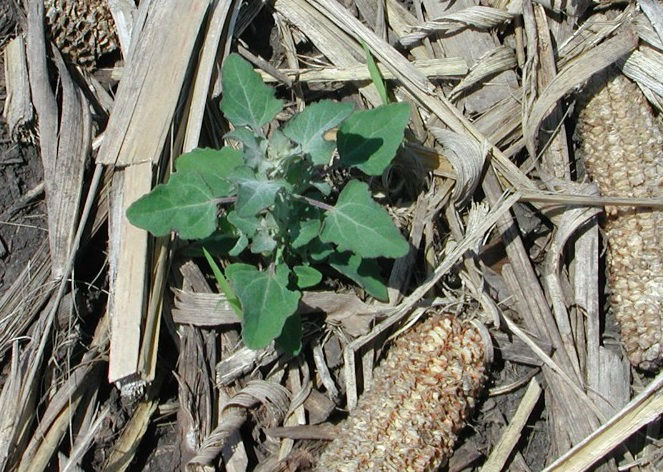
Figure 12. Common lambsquarters germinates before corn planting with leaves covered with a powdery coating. Leaves form in an opposite pattern and plants can grow almost six feet tall. Some lambsquarters may be resistant to ALS-inhibitor and Photosystem II inhibitor herbicides. There may also be reduced sensitivity to glyphosate.4
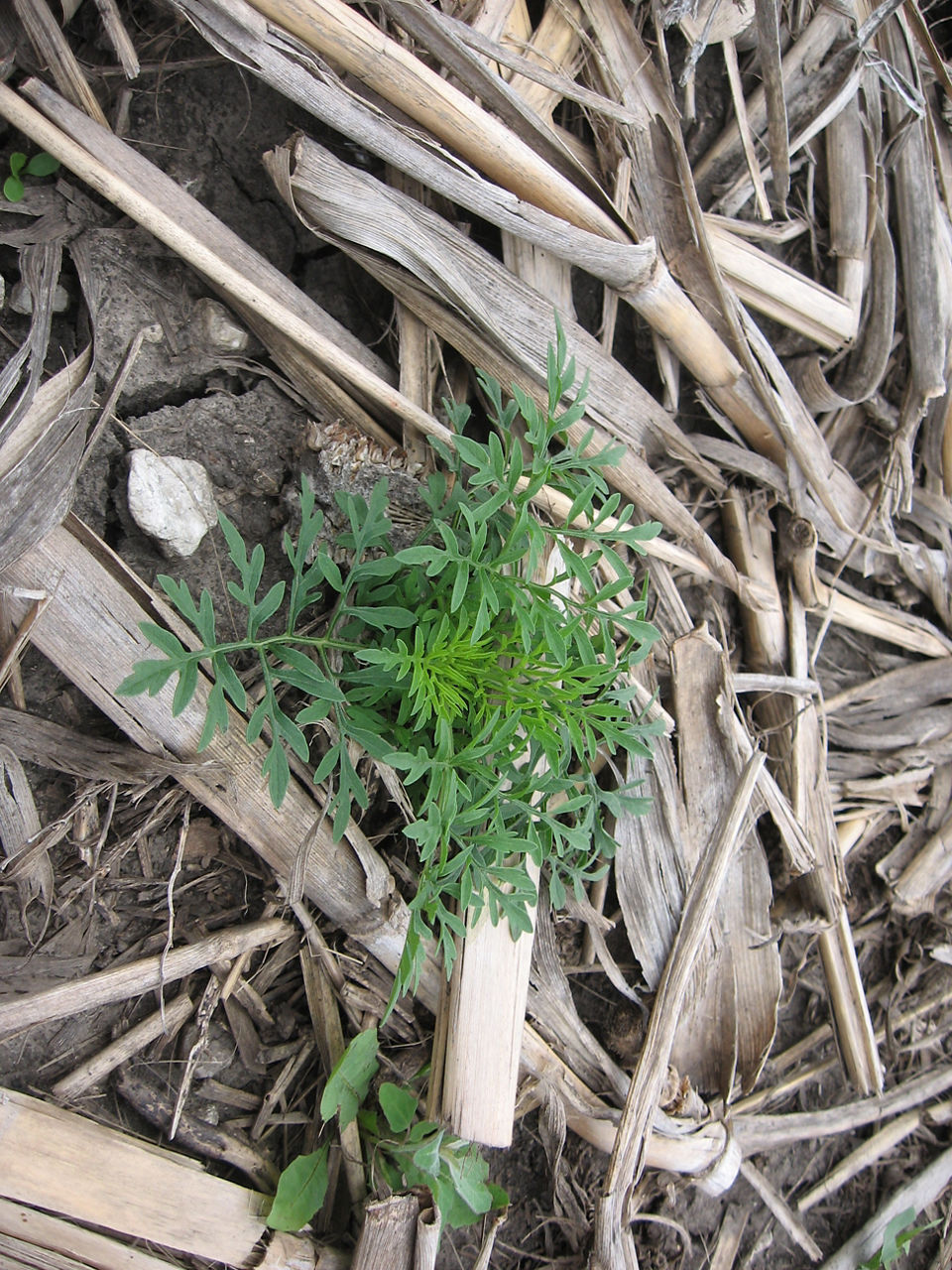
Figure 13. Common ragweed seedling. Triangular shaped leaves that are finely divided and hairy. First leaves are opposite; however, later leaves are alternate. Mature plants can reach heights of 6 feet.
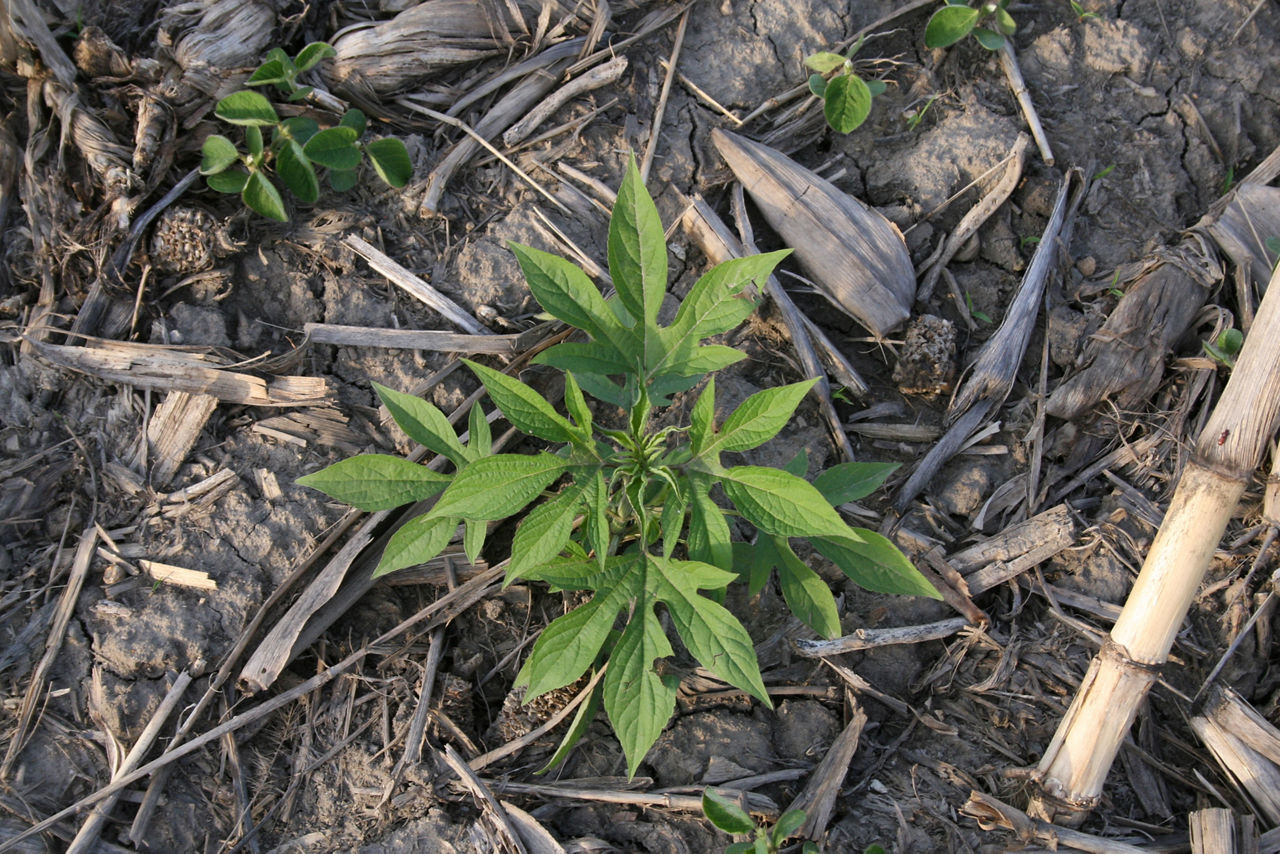
Figure 14. Young giant ragweed. Cotyledons are round to paddle shaped and the stem is shiny and green with purple spots. Mature plants are usually 3 to 12 feet tall. Stems are single or branched with short hair. Leaves can be 12 inches long and 8 inches wide and are opposite.

Figure 15. Yellow rocket rosette. Yellow rocket (mustard family) has egg-shaped to round cotyledons with a slightly notched apex and long stem. Early leaves are round with heart shaped base and wavy or entire margins. Leaves are alternate. Yellow flowers have four petals.7 Picture courtesy of and used with the permission of Bruce Ackley, The Ohio State University, Bugwood.org.

Figure 16. Cressleaf groundsel rosette. Cressleaf groundsel (aster family) germinates in the fall and develops a rosette. The basal rosette leaves are deep pinnate serrations with roundly lobed leaf margins. The stems of bolted plants are hollow. Flowers are yellow with six to twelve rays.8 Picture courtesy of and used with the permission of Aaron Hager, University of Illinois.
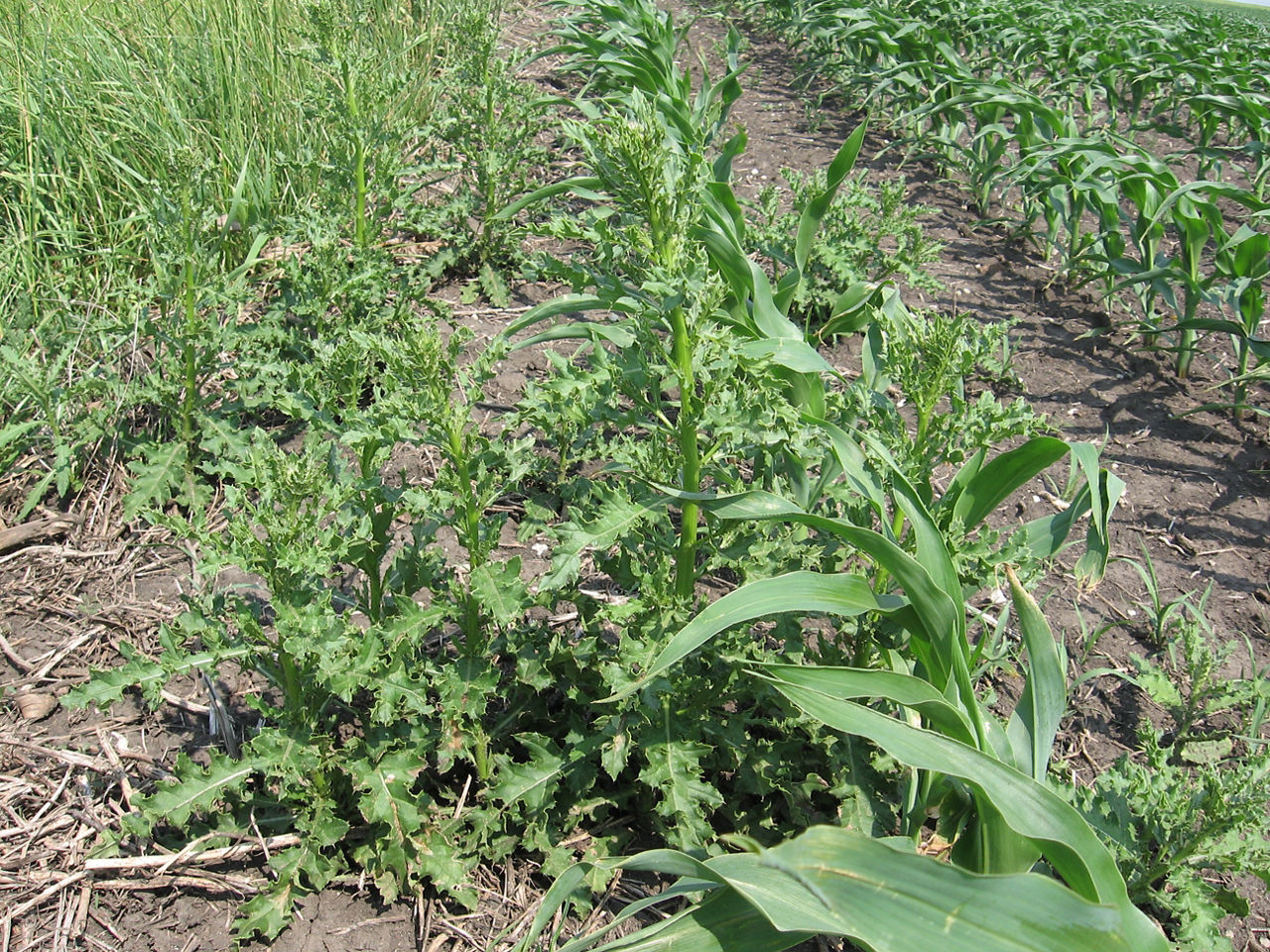
Figure 17. Canada thistle. As a perennial, growth usually begins in the spring, but new seeds may germinate in the fall and go dormmate until spring. The weed spreads by a creeping root system.9
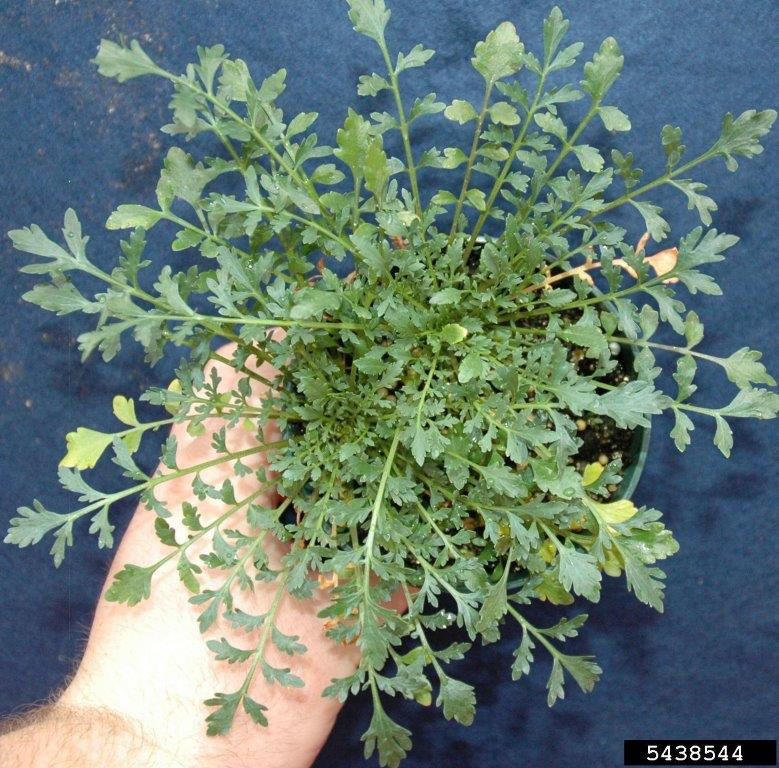
Figure 18. Virginia pepperweed rosette. An annual that emerges in early spring. Rosette leaves are hairless, lobed on both sides, lanceolate or linear, and without petioles.9 Picture courtesy of and used with the permission of Bruce Ackley, The Ohio State University, Bugwood.org.
Insect Activity and Scouting
The potential for an insect to become a pest in future corn fields depends on its life cycle, feeding habit, and tillage practices. Some insects, such as wireworms and true white grubs overwinter as larva, while others such as corn borers, overwinter in their pupal growth stage. Those overwintering as larvae can be potentially damaging to newly planted seeds and emerging seedlings while pupating insects can cause damage later in the growing season. Certain agronomic practices, such as no-till, continuous corn, manure applications, and cover crop growth can provide a medium for insects to thrive and become a concern. Life cycle knowledge is important as some insects, such as black cutworm and corn earworm, do not overwinter in the Midwest; therefore, potential infestations are dependent on southerly winds bringing the moths from overwintering southern locations to the Midwest.
Scouting includes digging around seedlings to look for wireworm, true white grub, or seedcorn maggot damage, inspecting corn leaf tissue around three feet tall for corn borer eggs, digging corn roots to evaluate for corn rootworm feeding, and placing sticky traps in soybean fields to monitor for western corn rootworm variant beetles. Scouting should be random and replicated through a field to get a representative sampling of insect activity as the feeding may be isolated to one area or widespread. Equipment for insect scouting may include a digging tool (garden trowel or spade), tape measure, a small vial or container filled with isopropyl alcohol to collect insect samples, and a bucket for root samples.
Damage from true white grubs (June beetle adult) in soybean or corn fields can be an indication that damage may occur in the next corn crop because the larvae can be present for three years (Figure 19).10 Other grubs including those of chafer beetle and Japanese beetle may be present. Identification between the species can be determined by observing the formation of tail hair, also known as the raster pattern (Figure 19).
Wireworms (Figure 20) can damage corn by boring into the growing point and killing or severely damaging it which can be observed as wilted or dead whorls. Buried grain-based bait stations can be used in the spring to help identify the potential for wireworm damage to seedling corn.11 If wireworms are found in the bait, consideration should be given to applying an insecticide at planting.
Residue from terminated cover and forage crops and fields treated with manure can be attractive to the adult fly of seedcorn maggot. The maggots hatch from eggs laid in the mat and feed on corn seed (Figure 21). Corn planted in these fields has the potential for seedcorn maggot damage.12
In areas where western corn rootworm (WCR) variant beetles are present, soybean fields should be scouted for their presence and population using sticky traps (Figure 22).13,14 Prior to the WCR adapting, WCR beetles fed and laid eggs in corn; however, the variant can survive by feeding on soybean plants and lays eggs in the soil surrounding the plants. The eggs laid in the soybean field soil can result in rootworm larvae feeding on future corn roots. The threshold in soybean fields is 1.5 western corn rootworm beetles/trap/day.15
Additionally, soybean fields with a high population of volunteer corn may have supported rootworm larvae and adults. Though not a usual problem, Japanese beetles can also be found feeding on soybean plants and can be an indication that they could infest a future corn field (Figures 19 and 22).
In continuous corn fields, the presence of European or southwestern corn borers in the current corn crop should be noted (Figure 23).16,17 The moths resulting from the overwintering larvae can lay eggs on corn leaves that result in the larvae feeding on leaves and stalks. If borers are present in previous continuous corn, consider using corn products protected with Bacillus thuringiensis (B.t.) traits. The moths will travel to the most attractive corn plants to lay eggs; therefore, non-continuous corn may be at risk of an infestation. Scouting during the growing season should be conducted in non-continuous corn.

Figure 19. True white grubs (June beetle adult) feed on plant roots. Severe feeding can cause plant wilting and death. True white grubs are potentially the most damaging in corn because they survive in the larval form for three years. Other grubs that can be found include chafer beetle larvae (L), Japanese beetle larvae (C), and June beetle larvae (R). The different species can be identified by the arrangement of hair on the tail.
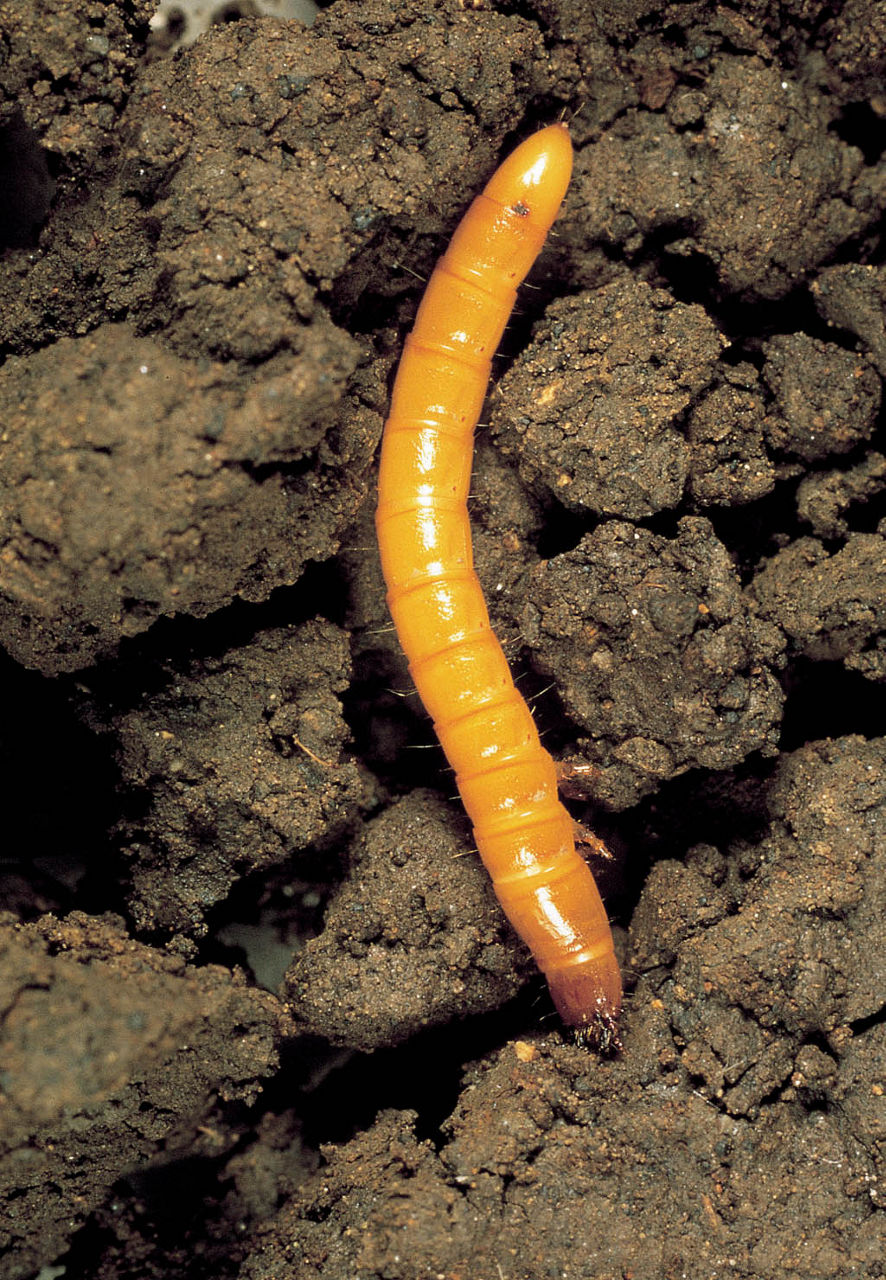
Figure 20. Wireworms live for several years in the soil and feed upon seedling corn plants by boring into the lower stem killing or severely damaging the growing point. Damaged seedlings may show center leaves being wilted or dead (dead heart) and have excessive tillering.

Figure 21. Seedcorn maggot. Larvae may be present in fields with terminated crop residue or fields treated with manure because the adult flies are attracted to the residue and lay eggs in the residue.
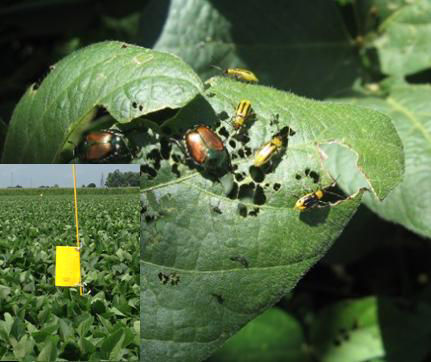
Figure 22. Western corn rootworm variant beetles and Japanese beetles feeding on soybean leaves. Insert shows a rootworm trapping device to measure rootworm infestation level.

Figure 23. European corn borer larva in ear shank (L) and southwestern corn borer larva feeding in base of corn plant (R). The adult moths emerge from overwintering pupae and lay eggs on corn leaves. As the eggs hatch, the larvae initially feed on leaf tissue before boring into stalk tissue. European corn borers can be found throughout the plant while southwestern corn borers migrate to the lower stalk and root. Having knowledge of feeding in continuous corn operations can allow for proactive management for future corn crops
Sources:
1Pittman, K., Flessner, M., and Ackroyd, V. Start the season out right: plant into weed-free fields. GROW. https://growiwm.org/plant-into-weed-free-fields/.
2Hartzler, B. 2009. Managing winter annual weeds in no-till fields. ICM News. Iowa State University. https://crops.extension.iastate.edu/cropnews/2009/04/managing-winter-annual-weeds-no-till-fields/.
3Werle, R. and Sandell, L. 2013. Managing winter annual weeds this fall. CROPWATCH. University of Nebraska. https://cropwatch.unl.edu/managing-winter-annual-weeds-starts-fall/.
4Clay, S.A. 2016. Selected broadleaf weeds in South Dakota corn fields. South Dakota State University. iGrow Corn: Best Management Practices. https://extension.sdstate.edu/sites/default/files/2019-09/S-0003-39-Corn.pdf.
5Hagar, A. 2020. A review of early-season weeds. Department of Crop Sciences. farmdoc. University of Illinois at Urbana-Champaign. https://farmdoc.illinois.edu/field-crop-production/weeds/a-review-of-early-season-weeds.html/.
6Sarangi, D. and Jhala, A. J. 2014. Identification of winter annual weeds. EC-304. University of Nebraska-Lincoln Extension. https://cropwatch.unl.edu/2020-CW-News/documents/ID-of-Winter-Weeds-EC-304.pdf.
7Yellow rocket. Cornell Weed Identification. Cornell University. https://blogs.cornell.edu/weedid/yellow-rocket/.
8Ikley, J. and Johnson, B. 2018. Cressleaf groudsel (Packera glabella). Pest & Crop Newsletter. Purdue University. https://extension.entm.purdue.edu/newsletters/pestandcrop/article/cressleaf-groundsel-packera-glabella-2/.
9Weed Id Guide, Division of Plant Sciences. University of Missouri. https://weedid.missouri.edu/.
10Varenhorst, A. J., Dunbar, M. and Hodgson, E. 2015. True white grub identification and management. Integrated Crop Management. Iowa State University. https://crops.extension.iastate.edu/cropnews/2015/06/true-white-grub-identification-and-management/.
11Esser, A. 2012. Wireworm scouting: The shovel method and the modified wireworm solar bait trap. Washington State University Extension Fact Sheet. FS059E. Washington State University. https://agresearch.montana.edu/wtarc/producerinfo/entomology-insect-ecology/Wireworms/WSUFactSheet.pdf.
12Obermeyer, J. 2009. Seedcorn maggot. Field Crops IPM. Purdue University. https://extension.entm.purdue.edu/fieldcropsipm/insects/corn-seedcorn-maggot.php/.
13Cook, K.A., Ratcliffe, S.T., Gray, M.E., and Steffey, K.L. 2005. Western corn rootworm variant. Scouting Information Sheet. Integrated Pest Management. University of Illinois. http://ipm.uiuc.edu/insects/western_corn_rootworm/wcr.pdf.
14Hammond, R. B., Michel, A., and Eisley, J. B. 2014. Monitoring western corn rootworm activity in soybeans to predict rootworm injury in first-year corn. ENT-17-14. Agriculture and Natural Resources Fact Sheet. The Ohio State University Extension. https://aginsects.osu.edu/sites/aginsects/files/imce/ENT_17_14%20Rootworm%20variant.pdf.
15Hodgson, E. and Gassman, A.J. 2016. Guidelines for using sticky traps to assess corn rootworm activity. Integrated Pest Management. Iowa State University. https://crops.extension.iastate.edu/cropnews/2016/06/guidelines-using-sticky-traps-assess-corn-rootworm-activity/.
16Wright, B., Jarvi, K., and Hunt, T. 2015. Begin scouting for 1st generation corn borers. CROPWATCH. University of Nebraska-Lincoln. https://cropwatch.unl.edu/begin-scouting-1st-generation-corn-borers#:~:text=To%20scout%20for%20corn%20borer,Record%20this%20information.
17Bessin, R. Southwestern corn borer. ENTFACT-108: Southwestern Corn Borer. Entomology at the University of Kentucky. University of Kentucky. https://entomology.ca.uky.edu/ef108/.
Web sites verified 10/3/22. 1223_52051